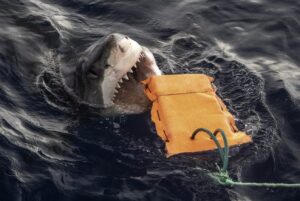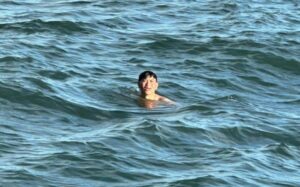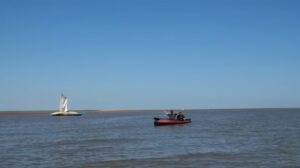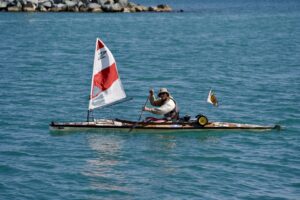On September 20, Cyril Derreumaux completed his 4,444km solitary kayak expedition from California to Hawaii. He spent 91 days and nine hours paddling across the Pacific Ocean and became the second person to make the arduous journey by kayak.
Derreumaux spoke to ExplorersWeb about his journey.
The interview has been edited for brevity and clarity.
Rowing vs kayaking
You’ve done the route before, but rowing in a team. How did this compare?
A rowing boat is much higher on the water, and much safer. It’s very powerful and you have a bigger reach, so you can have a bigger boat. There have been so many single rowers but there are only four people who have done kayak ocean crossings. Of course, there’s Ed Gillet who crossed from Monterey to Hawaii in an off-the-shelf double kayak and a kite. I was very inspired by Scott Donaldson, who crossed the Tasman Sea from Australia to New Zealand. And then there’s Alexander Doba and Peter Bray. It’s so seldom done that you have to learn much more and reinvent new things. [Note: In the 20th century, Franz Romer and Hannes Lindemann also crossed the Atlantic in kayaks.]
When I was rowing, I was in a four, and we were aiming to beat the Guinness record. That was 43 days, and it was all about performance and discipline. My crossing in a kayak was really different. My aim was to enjoy the ride. I usually do expeditions with other people, but with this, I was pushing my own boundaries. It was a smaller boat. It’s only 30 inches above the water so I could touch the water on both sides of the kayak. There was a much smaller cockpit and cabin. Being on your own, you have to be very self-aware of your mental state and be able to repair anything on the boat.
Ed Gillet: one of a kind
You followed the same route as Ed Gillet. Do you think you would be able to do the journey the way he did it?
This is really easy to answer. No. He’s a trailblazer. He’s somewhat of a maverick in some ways. If you read his book, he himself says that if he had done the trip 10 times, he would have died five times. So it’s not something I would do. For me, the success was to just safely cross and finish it.
He’s a legend in my eyes. He inspired me and I’ve been in touch with him many times. I think just the way he did it, sleeping in the cockpit with a tarp over himself, navigating with a sextant and no communication whatsoever, he was truly solo. I was solo because I was alone in the boat, but I had land support. I could text back and forth. I could even make a phone call when I had issues. He’ll never be reproduced.

Derreumaux’s route. Image: solokayaktohawaii.com
Meticulous training
Last year, you had to abandon your crossing. How did you feel going into the second attempt?
I think the work that I did between the two attempts was key. And I think the analysis of the first rescue was important. I realized that somehow I was not prepared because I did not succeed. I improved the boat itself so there was better side protection, got a manual pump so I could build and remove the water from the cockpit faster, and had an external antenna so I could make phone calls from inside the cabin. I spent five days on the coast of Santa Cruz training for high winds and had more time sleeping on the boat, and more time mental training.
I felt much better. I felt more prepared. There were still doubts, of course, but I felt really happy when I cast off the pier. I felt like this was my time, and this time I would not give up until I was literally sinking.
How did your family feel about you taking this trip after the first attempts ended in you being rescued?
I reassured them by really knowing what I was going into, being really prepared, having backup plans and backups of backups, and being really trained and showing that I was dedicated to it. One of my girlfriend’s best qualities is that she allows me to do this. I kind of said here’s the list of the risks, here’s what I will do in those situations, and I proved I was training to make sure I could mitigate any problems that came up.
Sardine-style sleeping
What was the sleeping arrangement on the boat?
Most of the time, the rolling and the rocking weren’t too much so I didn’t have to strap myself in. The cabin was about the size of a single tent. If I reached with my hand up, I would touch the roof really easily, and then on each side, my elbows touched. I only had the option of sleeping on my back. I had to put the pillow in such a way that my head would not rock too much, and I would be able to get some sleep. Off the coast of California, there’s a lot of traffic of tankers and boats, essentially. So at night, I would have to wake up every hour just to check that everything was okay.

Cyril Derreumaux makes it to Hawaii. Photo: Tome Gomes
Were you quite sleep-deprived?
It took two to three weeks to adapt to the new sleeping pattern. The first week was all adrenaline. I was pushing to do 12 hours a day. The hardest section was the first week. I was seasick as well. Then the second week was really exhausting physically so I would sleep just because I was exhausted.
It was important to practice feeling safe sleeping on the boat, and that was gradual. I built a wooden replica in my backyard, and I would spend afternoons in it. Then when the boat arrived in California, it was on the trailer and I would sleep on the trailer in the street. Then I put the boat on the dock and slept there. Eventually, I paddled and sleep in it. It was a gradual progression toward the skill I wanted.
Repetitive stress dangers
What toll did the expedition take on your body?
Doing anything for 90 days is hard so I trained for that repetitive motion. When you’re kayaking, you twist your core, so there could be problems with the lower back, the core, the rotation of the shoulders, the elbows, and the wrists. So I worked hard on my technique and learned from the other expeditions.
When Ed Gillet arrived in Hawaii after 63 days, his legs were atrophied. Sitting constantly is not healthy for the body. I wanted a way to work my lower body, so I asked Rob Pilot (the boat designer) to include a pedaling system. I alternated between that and paddling and that helped me a lot to be really healthy on the upper and lower body. We refitted the kayak so the pedaling system was between my legs in the cockpit. I could take it in and out in less than 20 seconds.
What was the most challenging part of the route?
The beginning and getting off the coast is always challenging. A compartment flooded very early on because of a leak and I had to create a drain system. Then my steering light got really stiff for some reason. Off the coast of California, it was foggy and cloudy all day, so it was hard to replenish batteries using solar panels. The watermaker broke, so I had to use the manual one. There were lots of small issues to overcome.
I think the first two or three weeks were the hardest, but then you get more secure in your boat and in your skills. After that, it’s more mental and it seems like Groundhog Day. Eventually, I got into a pattern where I just enjoyed the day, your mind just declutters and you’re completely free to have new thoughts.

Derreumaux and a friend in Hawaii. Photo: Tom Gomes
Magical moments
Was that your favorite aspect of the trip?
It’s the magical moments. You can’t look forward to them, they just happen. I remember after four days of really bad weather, there was one moment. It’s going to be in my mind forever. I just woke up and came out, and the rolling of the swell was just so soft. There was no wind, no sound whatsoever. And there was a beautiful sunrise. Its simplicity was just overwhelming. You can’t really explain it, it just happened and then you start to cry. This is magical.
You previously said you couldn’t really explain why you wanted to do this. Did you find answers on the water?
I really don’t have a straight answer. It just feels like an amazing adventure. To feel what it is to be in the middle of the ocean on your own and feel the waves, the rawness of nature, and the strength of the ocean. Something inside me that just draws me to it. I know there’s something I’m going to learn.
This time what I learned is that I already had it in me. Over the journey, I was really philosophical about life. I thought a lot about love and fraternity; that we should all consider each other brothers and sisters. All these values were ingrained in me, but this trip just revealed them to me in such intensity that now I’m going to live intentionally with these values as I go forward in life.
You feel a bit empty afterward
Do you have any future expedition plans?
A common thing about adventure is when you finish, you feel a bit empty. You think, “What now? What should I do? What is my brain going to work on?” I’m trying to refrain from doing a rebound challenge right now. I need to rest and recover properly. Obviously, there’s going to be adventure in my life forever.
I think next year is going to be about getting back in touch with real life. I already have some ideas for expeditions I could do, but it’s going to be for 2024, not 2023. I’m 46 and I lost 20 pounds and a lot of muscle. So it’s going to take me at least six months to recover and feel strong again.
Next year, I’d like to do a race up in the Yukon River. It’s only three days. I’ve done it in a six-man canoe, a four-man canoe, and a two-man canoe. So a one-man canoe or kayak could be good. Then maybe a big project for the year after. Don’t tell my girlfriend.






